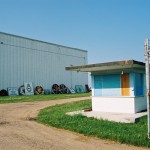
In the early 1950s, the Pinetree Line network of radar stations was established. This line, which featured a total of 44 stations, stretched along the 50th parallel, down the eastern coast and into southern Ontario and Quebec, and acted as an early warning detection system against a Soviet air attack.
In addition to the main radar stations, numerous un-manned Gap-filler radar sites were situated between each of the stations to fill in holes in coverage areas and detect any aircraft that were flying too low for detection by the main stations. Advances in Gap-filler radar technology led eventually to the disbandment of the volunteer civilian organization, the Ground Observer Corps, who were ordinary citizens trained to spot enemy and other unknown aircraft and report them to their local Filter Stations for action.
Advances in radar technology eventually enabled radars to increase their coverage areas, and radar stations were slowly closed as other stations were able to cover their area of responsibility.
Further technological advances would eventually lead to the demise of The Pinetree Line. Starting in the mid-1980s, the remaining Pinetree stations were all shut down as part of the North American Air Defence Modernization Plan, with the final stations closing in 1991.
For the full history of the following former Pinetree Radar stations, visit Ren L’Ecuyer’s Pinetree Line web site (now archived and run by the Communications & Electronics Museum in Kingston, Ontario) – The Pinetree Line Home Page (c-and-e-museum.org) or Larry Wilson’s Radar Tech Page – http://www.lswilson.ca/page5.htm.
or read “Abandoned Military Installations of Canada Volume I: Ontario”, “Abandoned Military Installations of Canada Volume II: Quebec”, “Abandoned Military Installations of Canada Volume III: Atlantic and “Abandoned Military Installations of Canada Volume IV: Western and Northern, all author Paul Ozorak.
The source material that I used is from the above sources and any others listed in the individual entry.
No military presence remains at the former Pinetree stations, although four sites have been retained by the DND as remotely-operated costal radar detachments.














10 pings
Skip to comment form ↓
Abandoned Military Base - CFS Foymount - Exploration Project
September 4, 2016 at 9:42 pm (UTC -5) Link to this comment
[…] CFS Foymount opened in 1952 as a radar and warning station. The radar was situation on top of 535 metre hill and was a part of the Pine Tree Line of Norad (North American Aerospace Defense Command) radar stations. These stations provided early warning in the case of a Soviet nuclear attack, which was of course, a looming concern at the time. CFS Foymount, however, was closed in 1974 due to other radar stations being powerful enough to cover its area of operation. […]